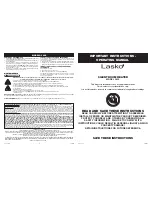
■
The heater must be installed in accordance with the
Australian Gas Installation Standard AS/NZS 5601.
■
The installer must test the operation of the appliance
to ensure it functions correctly before Customer
handover.
■
If the appliance does not function correctly, the
appliance must be removed from service immediately.
■
An authorized and properly trained gas heater service
person must be contacted to put the appliance back
into proper working order.
1. Read all safety precautions and follow L. B. White
recommendations when installing this heater. If during
the installation or relocating of heater, you suspect that
a part is damaged or defective, call a qualified service
agency for repair or replacement.
2. Make sure the heater is properly positioned before use
and is hung level. Observe and obey all minimum safe
distances of the heater to the nearest combustible
materials. Minimum safe distances are given on the
heater nameplate and on page 4 of this manual.
3. The heater is approved for outdoor installation only.
Read all instructions that accompany the respective
outdoor mounting kit for proper installation.
Outdoor mounting kit part numbers:
AD100 - 09811
AD250: 24097
4
Local, regional and national codes always apply to
regulator installation. Typically, the appliance’s gas
regulator, with pressure relief valve, should be installed
outside of the building. Any regulators inside the
building must be properly vented to the outside.
5. Ensure that all packaging has been removed prior to
installation. Any accessories, such as the sediment
trap that ship within the heater, must also be removed
and installed.
6. Make certain that a sediment trap is installed at the
gas valve inlet to prevent foreign materials (pipe
compound, pipe chips and scale) from entering the gas
valve. Debris blown into the gas valve may cause that
valve to malfunction resulting in a serious gas leak that
could result in a possible fire or explosion causing loss
of products, building or even life.
A properly installed sediment trap will keep foreign
materials from entering the gas valve and protect the
safe functioning of that important safety component.
7. For quick access in the event of an emergency, any
heater connected to a piping system must have an
accessible, approved manual shut off valve installed
within 1.83 meters of the heater it serves.
8. Check all connections for gas leaks using approved gas
leak detectors. Gas leak testing is performed as
follows:
-- Check all pipe connections, hose connections,
fittings and adapters upstream of the gas
control with approved gas leak detectors.
-- In the event a gas leak is detected, check the
components involved for cleanliness and
proper application of pipe compound before
further tightening.
-- Tighten the gas connections as necessary to
stop the leak.
-- After all connections are checked and any leaks
are stopped, turn on the main burner.
-- Stand clear while the main burner ignites to
prevent injury caused from hidden leaks that
could cause flashback.
-- With the main burner in operation, check all
connections, hose connections, fittings and
joints as well as the gas control valve inlet and
outlet connections with approved gas leak
detectors.
Installation Instructions
GENERAL
WARNING
Fire or Explosion Hazard.
Can cause property damage, severe injury or death.
1. Disconnect power supply before wiring to prevent
electrical shock or equipment damage.
2. To avoid dangerous accumulation of fuel gas, turn
off gas supply at the appliance service valve before
starting installation, and perform gas leak test after
completion of installation.
3. Do not force the gas control knob. Use only your
hand to turn the gas control knob. Never use any
tools. If the knob will not operate by hand, the
control should be replaced by a qualified service
technician. Force or attempted repair may result in
fire or explosion.
WARNING
Fire and Explosion Hazard
■
Do not use open flame (matches, torches, candles,
etc.) in checking for gas leaks.
■
Use only approved leak detectors.
■
Failure to follow this warning can lead to fires or
explosions.
■
Fires or explosions can lead to property damage,
personal injury or loss of life.
7








































